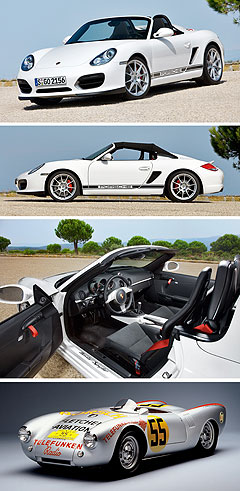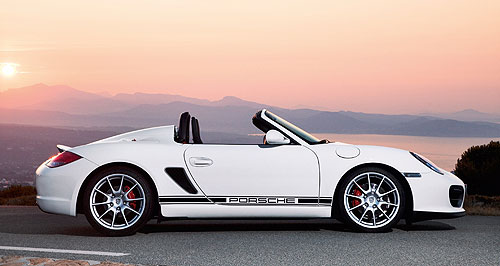Future models - Porsche - Boxster - SpyderFirst look: Porsche’s harder-core Boxster SpyderSpyder man: Porsche has re-created the Porsche Spyder, this time in the Boxster range. Faster, lighter, more serious Porsche Boxster emerges ahead of LA debut6 Nov 2009 PORSCHE has lifted the lid on a quicker, more powerful and even more focussed version of its evergreen Boxster convertible ahead of its world debut at the Los Angeles motor show on December 2. The Boxster Spyder will become a full-time member of Porsche’s model line-up in Australia from April next year, positioned above the regular Boxster and Boxster S. Designed to appeal directly to Californians’ penchant for stripped-out ‘Speedster’ versions of the 911 and Porsche’s iconic 356, the new Boxster flagship is expected to be priced above the Boxster S ($141,900) and perhaps even the Cayman S ($157,300). Rather than running the entry-level Boxster’s 188kW/290Nm 2.9-litre direct-injection flat six or the 228kW/360Nm 3.4-litre boxer engine from the Boxster S, however, the Spyder employs the higher-performance 235kW/370Nm engine from the hard-top Cayman S. Apart from 7kW of extra peak power and 10Nm more torque, the new top-shelf Boxster is also about 80kg lighter than the model upon which it is based. At just 1275kg, it will be the lightest model in Porsche’s entire range. The Spyder will also offer the best power-to-weight ratio within the compact, mid-engined sportscar line-up at about 184kW per tonne, which compares favourably with the Boxster S at 170kW per tonne, the Cayman S at 174kW per tonne and even the entry-level 911 Carrera (180kW per tonne).  Left: Porsche Boxster Spyder. Bottom: Porsche Spyder 550. Left: Porsche Boxster Spyder. Bottom: Porsche Spyder 550.Of course, that makes it the quickest Boxster with a claimed 0-100km/h acceleration time of 4.8 seconds when matched with the optional automated twin-clutch manual PDK transmission and Sports Chrono Package with launch control. In the same configuration, the Boxster Spyder returns average fuel consumption of just 9.3L/100km on the European combined cycle. However, although it is two-tenths quicker than the standard Boxster S, its roof must be removed for high-speed runs, giving it a higher co-efficient of drag and slightly reducing its official top speed figure, to a still-respectable 267km/h. Handling upgrades include a lower ride height and more focussed suspension tune, which combine with the lower kerb weight to reduce the Spyder’s centre of gravity. It is not clear if Porsche has ditched its sophisticated PASM variable-damping system in favour of lighter-weight fixed-rate units. Stylistically, the newest Boxster features lower side windows beneath a completely new, more lightweight and manually-operated canopy that replaces the standard Boxster’s automatic soft-top system, while the Boxster’s standard daytime running lights and fog lights have disappeared. Out back, two bulges on a single-piece engine cover attempt to create a ‘double-bubble’ silhouette reminiscent of the top-shelf Carrera GT, while the side air-intakes have been restyled and a new high-mounted brake light and extended rear spoiler added, giving the Spyder an altogether more sleek side profile. Inside, although power windows and mirrors are fitted, air-conditioning and a CD sound system will be optional extras for the Boxster Spyder. Other weight-saving cabin changes include a pair of lighter and more supportive bucket seats, plus belt-style door-pulls to replace the Boxster’s conventional interior door-handles. More than the limited-edition Boxster models that bore the Spyder name here in 2004 and 2008, Porsche’s most hard-core roadster is a highly modified version of a production model that attempts to recreate the formula pioneered by some of the Stuttgart-Zuffenhausen brand’s most famous race and road cars. The 550 Spyder of 1953 was the first Porsche sports car built specifically for racing and homologated for the road. Weighing in at just550kg, the mid-engined roadster proved victorious in a number of circuit and road races. It was followed by the 718 RS 60 in 1960 and the name continues to be used by the RS Spyder Le Mans Prototype racecar today.  Boxster pricing
Motor industry news |
Click to sharePorsche modelsResearch Porsche Boxster pricing
Motor industry news |














Facebook Twitter Instagram